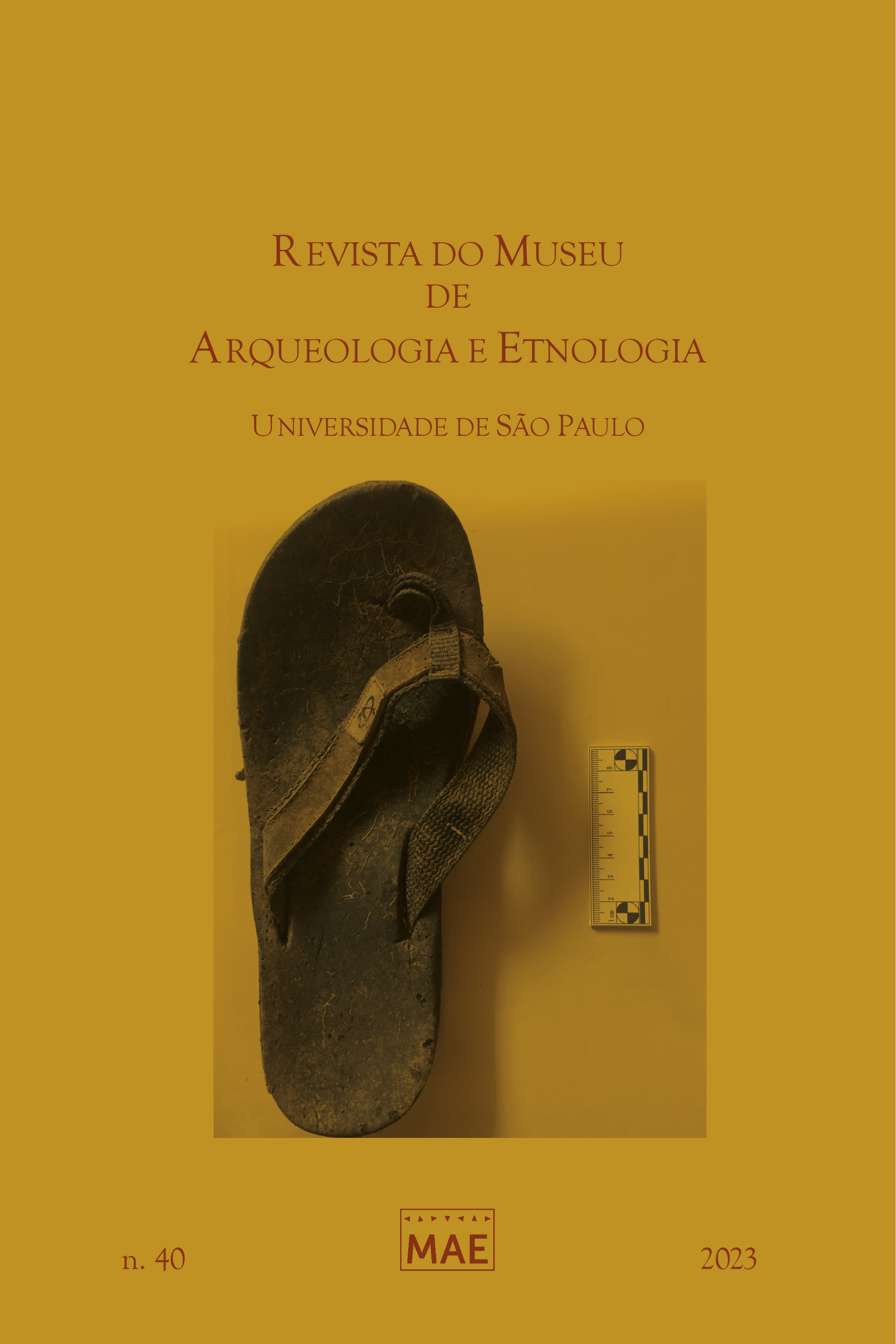O Programa Arqueológico Brasileiro no Egito: os primeiros seis anos na TT123: organizando o quebra-cabeças
DOI:
https://doi.org/10.11606/issn.2448-1750.revmae.2023.199944Palavras-chave:
Arqueologia, Egito antigo, Tumba tebana, Sheikh Abdel Qurna, BAPEResumo
Criado em 2015, o Programa Arqueológico Brasileiro no Egito (BAPE) tem como objetivo desenvolver pesquisas transversais e participativas em solo egípcio. Desde 2016 o BAPE vem desenvolvendo junto com o governo egípcio o Projeto Amenemhet, para a escavação da Tumba Tebana 123, localizada em Sheikh Abdel Qurna, Luxor. A tumba serviu como área de sepultamento no período faraônico e como residência na modernidade para famílias qurnawis. O objetivo deste artigo é apresentar os primeiros resultados das pesquisas conduzidas no local apresentando uma primeira interpretação baseada nos dados até agora levantados, tanto do ponto de vista arqueológico quanto histórico e etnográfico.
Downloads
Referências
Alberti, B.; Jones, A.; Pollard, J. 2013. Archaeology after interpretation: returning materials to archaeological theory. Routledge, New York.
Aubry, M. et al. 2009. Pharaonic necrostratigraphy: a review of geological and archaeological studies in the Theban Necropolis, Luxor, West Bank, Egypt. Terra Nova, 21: 237-256.
Aubry, M. et al. 2011. Geological setting of the Theban Necropolis: implications for the preservation of the West Bank Monuments. Orientalia Lovaniensia Analecta 204: 81-124.
Bakos, M. 1998. Three moments of Egyptology in Brazil. In: Eyre, C. (Ed.) Proceedings of Seventh International Congress of Egyptology. Cambridge University Press, Cambridge, 87-91.
Bakos, M. 2003. Egyptianizing motifs in architecture and art in Brazil. In: Humbert, M.; Price, C (Eds.). Imhotep today: Egyptianizing architecture. UCL Press, London, 231-245.
Barad, K. 2007. Meeting the universe halfway: quantum physics and the entanglement of matter and meaning. Duke University Press, Durham.
Bardají, T. et al. 2017. Geomorphology of Dra Abu el-Naga (Egypt): the basis of the funerary sacred landscape. Journal of African Earth Sciences 131: 233-250.
Blondeau, H.; Serdiuk, E. 2008. Observations de terrain au village de gurnet mar ‘ay : regards croisés entre l’architecture et l’anthropologie sociale et culturelle’. In: Broze, M.; Serdiuk, E. (Eds.). Villages d´Egypte: Gourna d´Hier À Aujord´hui: catalogue de l’exposition d’esquisses et de photographies créée au Cercle des Voyageurs à Bruxelles du 9 novembre au 1er décembre 2007. Centre d’Études Comparées des Civilisations Anciennes de l’Université Libre de Bruxelles, Bruxelles, 53-60.
Collins, L. 1976. The private tombs of Thebes: excavations by Sir Robert Mond 1905 and 1906. Journal of Egyptian Archaeology 62: 18-40.
Correas-Amador, M.; Simpson, C. 2017. Comparative evolution of vernacular mudbrick houses in the Nile Delta and Qurna (Luxor). In: Mileto, C. et al. 2017. Vernacular and Earthen Architecture: Conservation and sustainability. Routledge, London, 71-78.
Deleuze, G. 1987. A thousand plateaus: capitalism and schizophrenia. University of Minnesota Press, Minnesota.
Fábián, Z. 2011. A thébai el-Hoha domb déli lejtőjének feltárása Nefermenu TT 184 számú sziklasírjának körzetében: 2010. Orpheus Noster 3: 5-26.
Funari, P. 2010. Ancient Egypt in Brazil: a theoretical approach to contemporary use of the past. Archaeologies 6: 48-61.
Gardiner, A.; Weigall, A. 1913. A topographical catalogue of the private tombs at Thebes. Andesite, London.
Górecki, T. 2014. It might come in useful scavenging among the monks from the hermitage in MMA 1152. Études et Travaux 27: 130-150.
Kaczanowicz, M. 2020. Gordon Jelf and his notes on the work conducted in the Theban Necropolis, 1909-1910. Journal of Egyptian Archaeology 106: 37-58.
Kampp, F. 1996. Die thebanische Nekropole: zum Wandel des Grabgedankens von der XVIII bis zur XX Dynastie. Verlag Philipp von Zabern, Mainz am Rhein.
Mignolo, W. 2009. Epistemic disobedience, independent thought and de-colonial freedom. Theory, Culture & Society 26: 1-23.
Mond, R. 1905. Report of work in the necropolis of Thebes during the Winter of 1903-1904. ASAE 6: 71-200.
Pellini, J. 2018. Senses, affects and archaeology: changing the heart, the mind and the pants. Cambridge Schollars, Cambridge.
Pellini, J. 2021. Dung on the wall: ontology and relationality in Qurna: the case of TT123. Cambridge Archaeological Journal 31: 551-563.
Pellini, J. 2022. Encounters, affects and intra-actions: difracting the Theban tomb 123. Archaeologies 18: 338-369.
Säve-Söderbergh, T. 1953. On Egyptian representations of hippopotamus hunting as a religious motive. C.W.K. Glerupp, Upsala.
Settgast, J. 1963. Untersuchungen zu altägyptischen Bestattungsdarstellungen. J.J. Augustin, Glückstadt.
Shepherd, N; Gnecco, C.; Haber, A. 2016. Arqueología y decolonialidad. Ediciones del Siglo, Buenos Aires.
Simpson, C. 2010. Qurna: more pieces of an unfinished history. In Hawas, Z.; Ikram, S. Thebes and beyond: studies in honour of Kent R. Weeks. Supreme Council of Antiquities, Cairo, 197-218.
Spek, K. 2011. The modern Neighbours of Tutankhamun: history, life and work in the villages of the Theban west bank. American University in Cairo, Cairo.
Downloads
Publicado
Edição
Seção
Licença
Copyright (c) 2023 José Roberto Pellini, Caroline Murta Lemos

Este trabalho está licenciado sob uma licença Creative Commons Attribution-NonCommercial-NoDerivatives 4.0 International License.


















